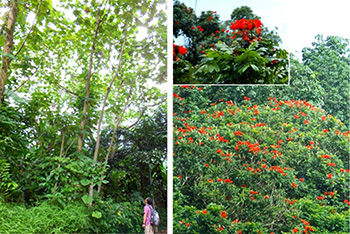Home > International Partnerships > Collaborative Research > Quantification of Invasion Risk of Exotic Trees and Functional Evaluation of Dominant Stand by Exotic Trees in Tropical Forests
Update:November 2, 2020
Main content starts here.
Quantification of Invasion Risk of Exotic Trees and Functional Evaluation of Dominant Stand by Exotic Trees in Tropical Forests

1. Partners
Universiti Putra Malaysia, Malaysia
Nanyang Technological University, Singapore
Kochi University, Japan
2. Research Period
FY 2020–2022 Grant-in-Aid for Scientific Research (KAKENHI)
3. Lead Researcher
TANAKA, Kenzo (Department of Plant Ecology)
4. Background
Tropical rainforests in Southeast Asia have huge biodiversity and high conservation value. However, these forests are rapidly deteriorating due to human activities. Invasion risk of alien species is also increasing. For example, in Singapore, where forest degradation has progressed for the longest time in the region, invasive alien plants species have become dominate forests all over the country. Quantifying the ecological characteristics of alien plant species and identifying the environment in which they preferable to invade are essential for predicting the future expansion of the distribution of alien species. Furthermore, little is known about forest functions such as carbon balance and dry matter production in the forest that dominated by alien trees.
5. Research Goal
In this project, we first clarify the preferable environment of the alien species by comparing plant ecological traits such as germination between alien and native species. Next, the functional characteristics such as carbon fixation capacity of the forest where the alien species dominate are evaluated.
6. Research Strategy
African tulip (Spathodea campanulata)and Cecropia spp. trees have expanded their range in Southeast Asia such as Singapore. The preferred germination and seedling establishment environment of these exotic species will be identified from nursery experiments and their distribution in the field. Tree census plots will be set up in forest stands dominated by those alien species to monitor their growth and survival.
7. Expected Outcomes
Identifying the environment where the exotic trees easily invade will be essential to conserve natural forests. If potential of carbon fixation in the forest where the alien trees dominate is clarified, the accuracy of the regional carbon balance will be improved.

Alien species of Cecropia (Left) and African tulip (Right)
Copyright © Forest Research and Management Organization. All rights reserved.
